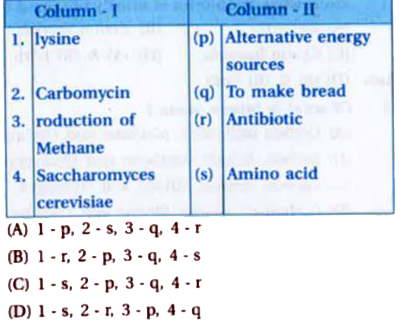Match the following columns Solution in Telugu
Solution in Telugu
The correct Answer is:A-q;B-p,s;C-r;D-t
Zero order: t12α1C0, 1st order t12= constant log(a−x)=loga−K×t2.303
2nd order rα(C0)2 3rd order rα(C0)3
Topper's Solved these Questions
- BOOK - AAKASH SERIESCHAPTER - CHEMICAL KINETICSEXERCISE - PRACTICE SHEET-2 (INTEGER ANSWER TYPE QUESTIONS)6videos
CHEMICAL KINETICS
- BOOK - AAKASH SERIESCHAPTER - CHEMICAL KINETICSEXERCISE - PRACTICE SHEET-3 (SINGLE OR MORE THAN ONE OPTION QUESTIONS)16videos
CHEMICAL KINETICS
- BOOK - AAKASH SERIESCHAPTER - CHEMICAL KINETICSEXERCISE - PRACTICE SHEET-2 (LINKED COMPRHENSION TYPE QUESTIONS)6videos
CHEMICAL KINETICS
- BOOK - AAKASH SERIESCHAPTER - CHEMICAL KINETCSEXERCISE - EXERCISE - 3.245videos
CHEMICAL KINETCS
- BOOK - AAKASH SERIESCHAPTER - CHEMICAL THERMODYNAMICSEXERCISE - Additional Practice Exercise54videos
CHEMICAL THERMODYNAMICS
Similar Questions
For a reaction the graph drawn between half life period and reciprocal of initial concentration(1/a) gives a straight line with positive slope. The magnitude of the slope is 500 and iniital concentration of the reactant is 2M. If the initial rate of the reaction is represented as x×10−3 units, then the value of x is _____________
View SolutionIt was found that for a reaction, on changin the temperature the t1/2 value get decreased. Hence it can be said that
05:12View SolutionElemantary unimolecular reactions have first order rate laws, elementary bimolecular reactions have second order rate laws. A rate law is often derived from a proposed mechanism by imposing the state approximation or by assuming that there is a pre -equilibrium. A proposed mechanism must be consistent with the experiment rate law.
The decomposition of O3 obeys the mechanism give below
Step 1: O3⇔O2+(O) (both forward and backward reactions are fast)
Step 2: O3+(O)slow−−→O2+O2 (ignore) backward reaction), the rate of reaction is given by04:28View SolutionDiscuss on the kinetic spontaneity of a chemical reaction. Is a slow reaction spontaneous? Why?
04:47View SolutionWhich among the following is not an exact differential?
04:16View SolutionMatch the following column with column
 03:04View Solution
03:04View SolutionMatch the following columns Column
 02:45View Solution
02:45View Solutionनिम्न कॉलमों का मिलान कीजिए। कॉलम ।
 03:29View Solution
03:29View Solutionनिम्न कॉलमों का मिलान कीजिए। कॉलम ।
 02:12View Solution
02:12View Solutionनिम्न कॉलमों का मिलान कीजिए। कॉलम ।
 03:22View Solution
03:22View Solutionनिम्न कॉलमों का मिलान कीजिए। कॉलम ।
 03:05View Solution
03:05View Solutionनिम्न कॉलमों का मिलान कीजिए। कॉलम ।
 04:35View Solution
04:35View Solutionनिम्न कॉलमों का मिलान कीजिए। कॉलम ।
 02:14View Solution
02:14View Solutionनिम्न कॉलमों का मिलान कीजिए। कॉलम ।
 05:03View Solution
05:03View Solutionनिम्न कॉलमों का मिलान कीजिए। कॉलम ।
 03:29View Solution
03:29View Solutionनिम्न कॉलमों का मिलान कीजिए। कॉलम ।
 02:54View Solution
02:54View Solution
